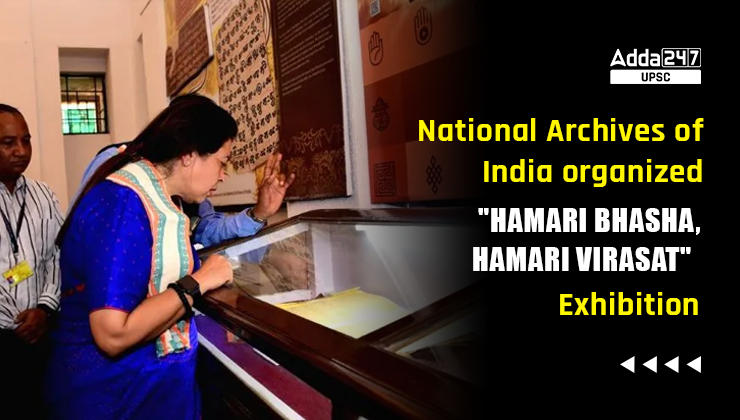Table of Contents
Hamari Bhasha, Hamari Virasat Exhibition: The “Hamari Bhasha, Hamari Virasat” exhibition at the National Archives of India stands as a testament to the cultural tapestry woven by India’s diverse languages and serves as a platform to appreciate and preserve this invaluable linguistic heritage for generations to come. Hamari Bhasha, Hamari Virasat Exhibition is also important for UPSC Prelims Exam and UPSC Mains Exam (GS Paper 1- Art and Culture).
Hamari Bhasha, Hamari Virasat Exhibition in News
Smt. Meenakashi Lekhi, Minister of State for Culture, inaugurated an exhibition titled “Hamari Bhasha, Hamari Virasat” at the National Archives of India, New Delhi.
- The “Hamari Bhasha, Hamari Virasat” exhibition was organized under the Azadi Ka Amrit Mahotsav (AKAM) initiative and aimed to commemorate the 75th International Archives Day.
- On the occasion of International Archives Day, National Archives of India has made available the Gilgit Manuscripts written between the 5″ -6″ centuries CE, which is the oldest surviving manuscript collection in India.
Hamari Bhasha, Hamari Virasat Exhibition
The “Hamari Bhasha, Hamari Virasat” exhibition is an endeavour to commemorate the treasured heritage of India’s linguistic diversity as a Nation: “राष्ट्र एक भाषा अनेक” India is blessed with extraordinary language diversity.
- The exhibition showcases a curated collection of original manuscripts sourced from the archival repository, including significant documents like the birch-bark Gilgit manuscripts, Tattvartha Sutra, Ramayana, Srimad Bhagwad Gita, and more.
- It also features official government files, banned literature from the colonial era, private manuscripts of renowned personalities, and rare books from the NAI Library’s extensive collection.
Hamari Bhasha, Hamari Virasat Exhibition Significance
On the occasion of our 75th Independence Day, the National Archives of India present an exhibition that commemorates the rich linguistic diversity of our nation.
- According to an estimate out of 7,111 languages spoken globally, about 788 languages are spoken in India alone.
- India is thus one of the four most linguistically diversified countries in the world, along with Papua New Guinea, Indonesia, and Nigeria.
- Throughout history, the languages of India have captivated the attention not only of native speakers but also of foreigners, who have conducted extensive studies on Indian languages, as seen in notable endeavors like the Linguistic Survey of India.
National Archives of India Details
The Imperial Record Department, which later became the National Archives of India, was established on March 11, 1891, in Kolkata (Calcutta). With the capital’s transfer to Delhi in 1911, the current building of the National Archives of India was constructed in 1926, designed by Sir Edwin Lutyens. By 1937, the relocation of all records from Calcutta to New Delhi was successfully completed. The National Archives of India plays a crucial role as the central authority for implementing the Public Records Act, 1993, and the Public Record Rules, 1997.
National Archives of India Collections
The National Archives of India currently houses an extensive collection of records encompassing a wide range of materials. This collection includes files, volumes, maps, bills assented to by the President of India, treaties, rare manuscripts, oriental records, private papers, cartographic records, an important collection of Gazettes and Gazetteers, Census records, assembly and parliament debates, proscribed literature, travel accounts, and more. A significant portion of the Oriental records comprises documents in languages such as Sanskrit, Persian, Arabic, and others.
‘Sustain: The Craft Idiom’ Cultural Exhibition at 2nd G20 Cultural Working Group Meeting
| Follow US |
| UPSC Govt Jobs UPSC Current Affairs UPSC Judiciary PCS Download Adda 247 App here to get the latest updates |



 TSPSC Group 1 Question Paper 2024, Downl...
TSPSC Group 1 Question Paper 2024, Downl...
 TSPSC Group 1 Answer key 2024 Out, Downl...
TSPSC Group 1 Answer key 2024 Out, Downl...
 UPSC Prelims 2024 Question Paper, Downlo...
UPSC Prelims 2024 Question Paper, Downlo...
